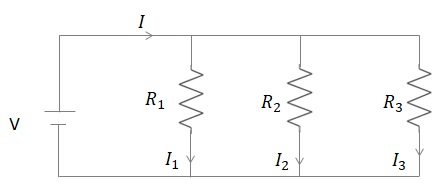
How many $176\Omega $ resistors (in parallel) are required to carry 5A in 220V line?
Answer
527.7k+ views
Hint: The net resistance for two resistors of resistances $\left( {{R}_{1}} \right)$and $\left( {{R}_{2}} \right)$connected in parallel is given by; \[\dfrac{1}{{{R}_{parallel}}}=\dfrac{1}{{{R}_{1}}}+\dfrac{1}{{{R}_{2}}}\], where the net resistance is \[\left( {{R}_{parallel}} \right)\]. Further, the Ohm’s law will also be used. The Ohm’s law is given by: $V=IR$.
Complete step by step solution:
Let’s find out how a parallel resistance circuit works. A parallel resistance circuit is made below.

The voltage source is (V) and the net amount of current flowing through the circuit is (I). There are three resistances: \[\left( {{R}_{1}} \right)\], \[\left( {{R}_{2}} \right)\] and \[\left( {{R}_{3}} \right)\]connected in parallel to each other. The amount of current through each branch of resistor is given by: \[\left( {{I}_{1}} \right)\], \[\left( {{I}_{2}} \right)\] and \[\left( {{I}_{3}} \right)\].
The values of the individual amount of current through each resistance, can be found through the Ohm’s law: $V=IR\Rightarrow I=\dfrac{V}{R}$. Hence, the value \[\left( {{I}_{1}} \right)\]is: \[{{I}_{1}}=\dfrac{V}{{{R}_{1}}}\]. Similarly, the value of \[\left( {{I}_{2}} \right)\]is: \[{{I}_{2}}=\dfrac{V}{{{R}_{2}}}\] and the value of \[\left( {{I}_{3}} \right)\]is: \[{{I}_{3}}=\dfrac{V}{{{R}_{3}}}\]. Using the Kirchoff’s current law: $I={{I}_{1}}+{{I}_{2}}+{{I}_{3}}$.
Hence, $I={{I}_{1}}+{{I}_{2}}+{{I}_{3}}$ becomes: $I={{I}_{1}}+{{I}_{2}}+{{I}_{3}}\Rightarrow \dfrac{V}{R}=\dfrac{V}{{{R}_{1}}}+\dfrac{V}{{{R}_{2}}}+\dfrac{V}{{{R}_{3}}}\Rightarrow \dfrac{1}{R}=\dfrac{1}{{{R}_{1}}}+\dfrac{1}{{{R}_{2}}}+\dfrac{1}{{{R}_{3}}}$.
Let’s consider a special case of the resistances connected in parallel. In this case, the resistances are of same value, that is: $\dfrac{1}{{{R}'}}=\dfrac{1}{R}+\dfrac{1}{R}+\dfrac{1}{R}\Rightarrow \dfrac{1}{{{R}'}}=\dfrac{3}{R}\Rightarrow {R}'=\dfrac{R}{3}$. Hence, the net resistance of the circuit becomes one-third the value of the resistance in each branch.
Using the same formulation for N branches, we get: ${{R}_{net}}=\dfrac{R}{N}\to (1)$, where (R) is the resistance of each branch and (N) are the number of branches.
For the current problem, we have multiple $176\Omega $ in parallel to each other. These are connected to 220V line and the net current is 5A. Hence using the Ohm’s law and the value of resistance from equation (1), we get: $V=I{{R}_{net}}\Rightarrow 220=5\left( \dfrac{176}{N} \right)\Rightarrow N=\left( \dfrac{176}{44} \right)\Rightarrow N=4$.
Hence, 4 of the $176\Omega $ resistors in parallel would be required to get a net current of 5A flowing through a 220V line.
Note: It’s important to remember that in a parallel resistance circuit connection, the voltage drawn by all the resistances are equal. An everyday example of this is the way electricity reaches all our houses. The constant 220V voltage is supplied to all the households in a locality, since all the houses are in a parallel connection to each other.
Complete step by step solution:
Let’s find out how a parallel resistance circuit works. A parallel resistance circuit is made below.

The voltage source is (V) and the net amount of current flowing through the circuit is (I). There are three resistances: \[\left( {{R}_{1}} \right)\], \[\left( {{R}_{2}} \right)\] and \[\left( {{R}_{3}} \right)\]connected in parallel to each other. The amount of current through each branch of resistor is given by: \[\left( {{I}_{1}} \right)\], \[\left( {{I}_{2}} \right)\] and \[\left( {{I}_{3}} \right)\].
The values of the individual amount of current through each resistance, can be found through the Ohm’s law: $V=IR\Rightarrow I=\dfrac{V}{R}$. Hence, the value \[\left( {{I}_{1}} \right)\]is: \[{{I}_{1}}=\dfrac{V}{{{R}_{1}}}\]. Similarly, the value of \[\left( {{I}_{2}} \right)\]is: \[{{I}_{2}}=\dfrac{V}{{{R}_{2}}}\] and the value of \[\left( {{I}_{3}} \right)\]is: \[{{I}_{3}}=\dfrac{V}{{{R}_{3}}}\]. Using the Kirchoff’s current law: $I={{I}_{1}}+{{I}_{2}}+{{I}_{3}}$.
Hence, $I={{I}_{1}}+{{I}_{2}}+{{I}_{3}}$ becomes: $I={{I}_{1}}+{{I}_{2}}+{{I}_{3}}\Rightarrow \dfrac{V}{R}=\dfrac{V}{{{R}_{1}}}+\dfrac{V}{{{R}_{2}}}+\dfrac{V}{{{R}_{3}}}\Rightarrow \dfrac{1}{R}=\dfrac{1}{{{R}_{1}}}+\dfrac{1}{{{R}_{2}}}+\dfrac{1}{{{R}_{3}}}$.
Let’s consider a special case of the resistances connected in parallel. In this case, the resistances are of same value, that is: $\dfrac{1}{{{R}'}}=\dfrac{1}{R}+\dfrac{1}{R}+\dfrac{1}{R}\Rightarrow \dfrac{1}{{{R}'}}=\dfrac{3}{R}\Rightarrow {R}'=\dfrac{R}{3}$. Hence, the net resistance of the circuit becomes one-third the value of the resistance in each branch.
Using the same formulation for N branches, we get: ${{R}_{net}}=\dfrac{R}{N}\to (1)$, where (R) is the resistance of each branch and (N) are the number of branches.
For the current problem, we have multiple $176\Omega $ in parallel to each other. These are connected to 220V line and the net current is 5A. Hence using the Ohm’s law and the value of resistance from equation (1), we get: $V=I{{R}_{net}}\Rightarrow 220=5\left( \dfrac{176}{N} \right)\Rightarrow N=\left( \dfrac{176}{44} \right)\Rightarrow N=4$.
Hence, 4 of the $176\Omega $ resistors in parallel would be required to get a net current of 5A flowing through a 220V line.
Note: It’s important to remember that in a parallel resistance circuit connection, the voltage drawn by all the resistances are equal. An everyday example of this is the way electricity reaches all our houses. The constant 220V voltage is supplied to all the households in a locality, since all the houses are in a parallel connection to each other.
Recently Updated Pages
Physics and Measurement Mock Test 2025 – Practice Questions & Answers

10 Best Commerce Colleges in India

Benefits of Participating in SOF Olympiad 2023-24

Personalized Tuition for IGCSE Biology: Proven Results for 2025

1-on-1 Online Tuition for IELTS, SAT & International Tests 2025

Low Rank in JEE Main 2020? Try in These Engineering Colleges

Trending doubts
When was the first election held in India a 194748 class 12 sst CBSE

Which are the Top 10 Largest Countries of the World?

Differentiate between homogeneous and heterogeneous class 12 chemistry CBSE

Name the Union territory having the highest density class 12 biology CBSE

Why is the cell called the structural and functional class 12 biology CBSE

KnockKnee syndrome results due to pollution of A Heavy class 12 biology CBSE




